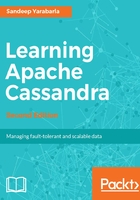
Structured records
The first three database features we looked at are commonly found in distributed data stores. However, databases such as Riak and Voldemort are purely key value stores; these databases have no knowledge of the internal structure of a record that's stored in a particular key. This means useful functions such as updating only part of a record, reading only certain fields from a record, or retrieving records that contain a particular value in a given field are not possible.
Relational databases such as PostgreSQL, document stores such as MongoDB, and, to a limited extent, newer key-value stores such as Redis, do have a concept of the internal structure of their records, and most application developers are accustomed to taking advantage of the possibilities this allows. None of these databases, however, offer the advantages of a masterless distributed architecture.
In Cassandra, records are structured much in the same way as they are in a relational database—using tables, rows, and columns. Thus, applications using Cassandra can enjoy all the benefits of masterless distributed storage while also getting all the advanced data modeling and access features associated with structured records.